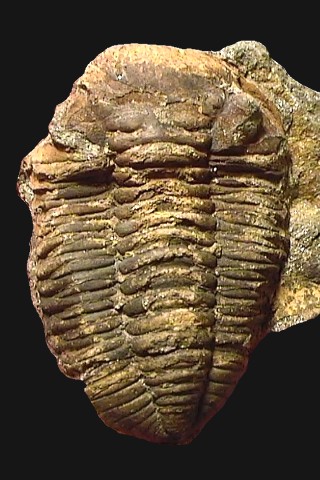
Specimen description :
- Almost complete : small left part of the pygidium and lef eye missing.
- Dorsal view.
- On a chip of matrix.
- Total size : 28 mm.
- Ordovician - basal Caradoc.
- Marrolithus bureaui Zone.
- Guichen, Ille-et-Villaine.
- France.
Phacopidina micheli micheli TROMELIN 1877
This is a trilobite which genera is uncertain, belonging to 2 different families according to the writers. This is why one can read incertæ sedis in the diagnosis. Rábano and Struve class it in the Calmoniidæ but classically, it has been described as belonging to the Phacopidinæ.
 |
Specimen description :
|
|
Complete view of the specimen.
|
Diagnose :
|
Order
|
Phacopida
|
SALTER 1864
|
Occurrence: Lower Ordovician (Tremadoc) to Upper Devonian (Famennian).
|
|
Sub-order
|
Phacopina
|
STRUVE 1959
|
|
|
Superfamily
|
Phacopoidea
|
HAWLE & CORDA 1847
|
|
|
Family
|
Phacopidæ
|
HAWLE & CORDA 1847
|
|
|
Subfamily |
incertæ sedis (Phacopidinæ ? Calmoniidæ ?) |
|
If one considers
this trilobite as a phacopidine, one has to refer to the diagnosis of Chotecops
: The Exoskeleton is almost entirely strongly inflated, notably at the
cephalon
|
|
Genus |
Phacopidina |
BANCROFT 1949 |
|
|
Species |
micheli |
TROMELIN 1877
|
|
|
Subspecies |
micheli |
Complementary pictures :
 |
 |
|
Dorsal view of the cephalon (B&W).
|
Dorsal view of the pygidium (B&W).
|
 |
|
Differential diagnoses :
Phacopidina micheli couyerensis.
The distinction is relatively dfficult to make and one has sometimes to eventually consider the identification via geographic criteria only.
|
Species |
micheli |
HENRY 1980
|
Occurence : Lower Caradoc (Upper part, "zone à Marrolithus bureaui") of the Andouillé formation - synclinorium of Menez-Belair.
|
|
Subspecies |
couyerensis |
Phacopidina micheli ssp.
|
Species |
micheli |
?
|
Occurence : upper part of the Postolonnec formation (Finistère), in the stages just under the "zone à Marrolithus bureaui" (llandeilo ?) and rarely under the "grès de Kerarvail" (Abereidian).
|
|
Subspecies |
ssp. |